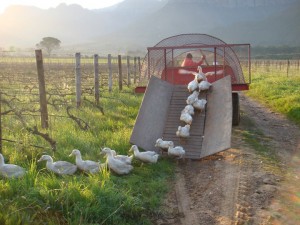It is easy to get the impression that, apart from conventional practices, there are only two options available in viticulture: organic and biodynamic. However, there are other methods being developed.
In Australia several wineries have opted to use only some biodynamic methods, but not all, without looking to obtain certification. The idea behind this selective approach is to use the practices that seem to work best for the particular conditions of a vineyard, and combining them with other methods. Other Australian vineyards use a microbial approach to soil balance, developed by Environmental Research and Information Consortium (ERIC), sometimes in combination with—and sometimes without—various biodynamic practices. This use of microorganisms and natural bacteria is not included in the standard biodynamic school, but it can also offer significant results.
The Bio-Logic approach
Jonathan Grieve, of Avondale Wines in Paarl, South Africa, developed an interesting alternative to biodynamic farming. Jonathan calls his method Bio-Logic, as he feels it is a logical approach to obtaining balance in the vineyards. Bio-Logic has many similarities with the biodynamic method: both methods grow grapes organically, but use additional means to obtain balance in the ecosystem. Jonathan has combined different parts of biodynamic and organic methods with modern science to come up with his own approach. He also uses the Albrecht system of soil balancing, based on determining the necessary ratios of mineral nutrients in the soil. By evaluating the state of a particular soil, Dr Albrecht—an American scientist who researched soil health—argued that it was possible to balance the soil using minerals from natural sources like rock dusts or deep sea kelp. This way, depending on particular circumstances, the soil can be balanced with calcium, magnesium, potassium, sodium, or other nutrients.
Jonathan’s overall idea is to work with nature to encourage life in the ecosystem and to try to return it to the state it would have been centuries before. Looking at a Bio-Logic vineyard, it is a bit wild with many native cover crops encouraged. The idea is to use the cover crop to bind nitrogen. This is carried out by free-living nitrogen-fixing bacteria in the soil or water forming colonies in nodules they create on the roots.
The Bio-Logic approach differs from organic and biodynamic viticulture as no compost, manure, or organic fertilizer is used. Cover crops, mulching, and some natural preparations like humic acid, BD preparations, aloe extracts, and more are used to stimulate fungi growth and bacterial populations. These, in return, provide nutrients for the vines.
“Once the system is in balance,” explains Jonathan, “the vine will control its own nutrient sources. When the vine needs nitrogen for growth, it will secrete basic sugars on its roots. This is food for a certain group of fungi and bacteria, which then contribute the nitrogen the vine needs. When the vine needs to set its fruit, and when veraison occurs, the vine needs potassium, not nitrogen. It will then secrete a different food source that attracts a different microflora, which provides the potassium.”
Another part of the program is to apply sea-solids, an idea pioneered by an American physician called Maynard Murray, seen as a natural way to remineralize the soil. Seawater from the Atlantic Ocean is taken from South Africa’s west coast and concentrated into a mineral rich solution that is applied to the soil. The solution returns minerals that would have been in the soil a long time ago and that were, over the ages, eroded out of the soil and into the ocean. By harvesting these mineral elements and re-applying them on the soils, the argument goes, the soils can be returned to their natural state.
Other issues are addressed using natural predators. A flock of ducks controls the snail population, natural Bacillus strains are used against worms and downy mildew, and a predatory wasp has been very efficient to clear the vineyard from mealy bugs. Owls and hawks are taking part in the natural control, and biodiversity in general is encouraged. To assiste with this process, 27 kinds of indigenous trees have been planted. As these trees flower at varying times, they attract different types of animals, stimulating biodiversity and the return of wild cats, rabbits, hawks, owls, and eagles. Tall poles in the vineyards and orchards give the hawks and eagles good locations from which they can see and catch mice and rats. The cover crops in the vineyards are made up of different indigenous plants, the aromatic kooigoed and kouterbos, wild sage and a wild, aromatic rosemary called kapokbos or snow white and three nitrogen-fixing varieties. All this has brought the wildlife back into the vineyard.
Part of the system also consists of constant monitoring, the vine being seen as the best indicator of soil quality. Leaf samples from the vines are collected to determine the nutritional status of the vines. Measurements are taken for pH, conductivity, and Brix, among others. This way, it’s possible to see how the soil balance is progressing and whether adjustments are needed.
Adapting to local conditions
This method can be a good natural solution for wineries that may not want—or be able—to work with composts and manure. For example, at Domaine Treloar, in Roussillon, Jonathan Hesford is looking at the best ways to have a healthy vineyard in balance, but for him the biodynamic school is not the right choice. There are few cows in the region, manure is not easily available, and yarrow and other biodynamic ingredients are not necessarily present in the regional flora. He has already tried marine algae stimulants, and he believes the Bio-Logic method without composts and manures will work better for him.
Another example of different circumstances leading to different solutions is whether or not to spray the biodynamic 501 preparation, made essentially from pulverized quartz and seen in biodynamic theory as allowing increased photosynthesis and solar influence. In Australia, some wineries believe that the last thing they need is more solar exposure and simply do not use this diluted quartz solution. Some believe the contrary, and see it as an essential part of the total concept. Demeter certification for biodynamic farming requires at least one application per year of cow horn manure and horn silica, as well as the spreading of prepared manures on all areas of the vineyard. Not using the whole biodynamic package prevents a vineyard from being able to obtain certification—and eventually use it in marketing—but some viticulturists prefer to combine these practices with other natural solutions that can result in a healthy vineyard.
Adapting to different conditions and challenges, with the freedom to choose what one deems an appropriate set of measures can only be beneficial. After all, it is the end result that counts, and there are many ways a vineyard can come into balance.

Ulf Karlholm is based in Porto Alegre, in the south of Brazil. He writes the blog Bio Vinho in Portuguese. Ulf is a Brazilian wine agent for Tyrrell’s Wines, Avondale Wine, Cabernet de los Andes, Tomas Achaval and Matua Valley Wines and involved in wine sourcing for the importer Handpicked Wines in Stockholm.




